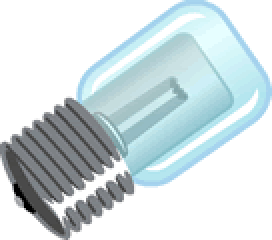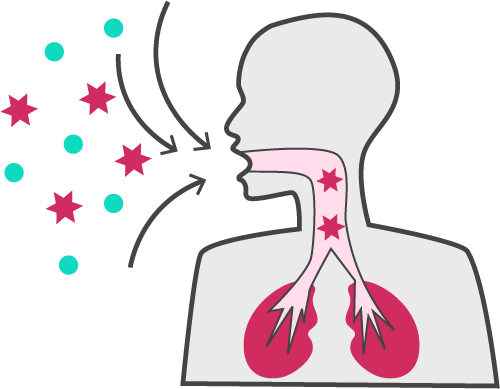There are various sources of radiation around us, including those that have been present in nature since the beginning of the Earth and those that are artificially created for medical and other applications. In this section, such radiation around us is explained.
Sources of radiation are present around us in nature. Though we cannot see or feel it, our bodies are always receiving radiation from nature. The amount of radiation we receive is about 2.1 mSv per year in Japan on average.
The term “average” is used here, because the amount of radiation varies depending on the location. Even within Japan, the difference in the amount of radiation can go up to about 0.2 mSv per year. Outside Japan, in some places, the amount of natural radiation goes up to 10 mSv per year. The world average is 2.4 mSv per year.
In addition to natural radiation, a Japanese person receives about 3.87 mSv per year on average for medical examinations and treatments.

It is radiation generated by human activities. Artificial radiation includes radioactive fallout from atmospheric nuclear explosion tests conducted by the US, former Soviet Union, China and other countries during the period from 1945 to 1980.
Also, nuclear facilities release radiation, although small in amount. In either case, the dose we receive is much smaller than the dose of natural radiation.
Other than these, artificial radiation is used in the field of medicine, such as X-ray examinations. It varies depending on the type, but it is said that the dose a person receives per examination is about 0.06 mSv in chest X-ray screening and about 0.6 mSv in abdominal X-ray screening.

This chart shows the change in the amount of strontium-90, one type of radioactive fallout, that fell in a month per square kilometer as contained in rainwater and dust (fallout) in Japan. As atmospheric nuclear tests were banned in 1980, the monthly strontium-90 fallout started to decrease.
However, it temporarily increased in 1986 due to the Chernobyl Nuclear Power Plant accident. Since then, the monthly strontium-90 fallout remained at levels about 1/20 of that in the 1970s, but it increased in March 2011 likely due to the accident at the TEPCO Fukushima Daiichi Nuclear Power Station.
Natural uranium is present around us in areas such as sea water and sands, and has been with us since the creation of the Earth. About 70% of natural radiation we receive in our daily life comes from natural uranium, thorium, and their daughter nuclides.
Thorium
A radioactive element with the atomic number of 90. It exists broadly in the earth’s crust, found in monazite, thorianite and thorite.
Natural uranium
A radioactive element with the atomic number of 92. It’s the heaviest among the 92 elements that occur naturally. It is contained in normal sands and sea water, albeit in small amounts. Uranium-235 makes up 0.7% of natural uranium. The remaining 99+% is uranium-238.

This diagram shows annual averages of air radiation dose rates measured monthly in each prefecture. The main source of air radiation is natural radiation from space and the earth.
Granite, that contains radionuclides such as uranium and thorium in relatively large quantities, is widely distributed in Western Japan, and therefore the air radiation dose rate in Western Japan is slightly higher than that in Eastern Japan.
Raw materials and ores
NORMs are contained in rock phosphate, monazite, titanium ore, natural gas, metal ore (e.g., tin), coal, and cement.

Commonly used products
NORMs are contained in the clock faces, glow starters for fluorescent lamps, antistatic coating (e.g., for lenses), smoke detectors, some ceramics, and glass products.

Radon is a gaseous radioactive material generated from radium, a daughter nuclide of natural uranium, which is taken into our bodies through breathing. Radium in the ground or building materials releases radon through radioactive decay, and the released radon disperses into the air.
Radon sometimes accumulates in a closed building, but can easily be released to the outside by opening the windows.

The annual effective dose of radon in Japan is about 1/3 of the global average. This is considered to be due to the differences in the geological nature and surveying in wooden buildings which have relatively higher ventilation rates.
However, recently, highly airtight concrete houses are on the rise in Japan, and it is possible that the indoor radon concentration increases in the future.


This chart shows the results of indoor radon concentration surveys conducted by Japan Chemical Analysis Center over a period of about 3 years from April 1993 to June 1996, for 20 households each in all the prefectures in Japan. Indoor radon concentration changes by ventilation and building materials used.
Inhaling highly concentrated radon for a long period of time may affect our bodies, such as decay products being deposited into the bronchi or lungs and causing lung cancer.
ICRP has set forth the basic approach and action level of radiological protection. For radon, ICRP recommends 200-600 Bq/m3 as an action level of indoor radon concentration (radon level that requires taking some action), which is adopted by various countries as appropriate.

To understand the neutron level in the environment, from FY2000 to FY2005, we conducted neutron dose rate surveys in Japan.
In addition, since neutrons in the environment originate from cosmic rays and they change according to solar activity, we conducted continuous measurement of neutron dose rates using a stationary rem counter and neutron spectra using a neutron spectrometer on our premises.
Results of neutron dose rate surveys in Japan

Change in neutron count rate (example)

